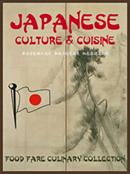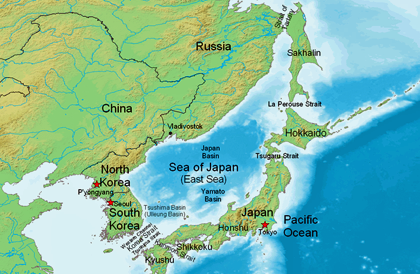|
Contents:
More:
E-book edition of "Japanese Culture & Cuisine" >
|
Brief History of Japan
Japan is an island nation consisting of 145,925 square miles. Located in the Pacific Ocean, the country is a cluster of more than six thousand islands with a collective population of nearly 128 million people. The four largest islands include Honshu, Hokkaido, Kyushu and Shikoku. The capitol city of Japan is Tokyo (known as Edo until 1868), located on the southwestern side of Honshu with a greater metropolitan population of more than thirty million people.
Japan is divided into forty-seven prefectures (todofuken), which are also known as sub-national jurisdictions. Prefectures are again subdivided into cities and districts within various regions, each one headed by an elected governor (chiji). The prefectures include the Hokkaido region, Tohoku region (Aomori, Iwate, Miyagi, Akita, Yamagata and Fukushima), Kanto region (Ibaraki, Tochigi, Gunma, Saitama, Chiba, Tokyo and Kanagawa), Chubu region (Niigata, Toyama, Ishikawa, Fukui, Yamanashi, Nagano, Gifu, Shizuoka and Aichi), Kansai region (Mie, Shiga, Kyoto, Osaka, Hyogo, Nara and Wakayama), Chugoku region (Tottori, Shimane, Okayama, Hiroshima and Yamaguchi), Shikoku region (Tokushima, Kagawa, Ehime and Kochi), Kyushu region (Fukuoka, Saga, Nagasaki, Kumamoto, Oita, Miyazaki and Kagoshima), and the Okinawa region. According to historians, the first known inhabitation of Japan occurred around 30,000 BC with a Paleolithic (Stone Age) culture. The first mention of Japanese people was written in the Chinese Book of Han in AD 111, which describes Japan as a group of islands they called Yamataikoku. Although Buddhism was introduced to Japan by Korea in the 6th century, it is believed China played a more influential role in the development of the religion, which now dominates the culture. Wealthy families (daimyo) and powerful warlords (shogun) defined the feudal period in Japan, which lasted from 1185 to 1868. Japanese nobility comprised roughly 12% of the population at the time, while the rest were peasants. Farmers ranked highest in peasant population, followed by craftsmen and merchants. Samurai warriors were part of the daimyo, enjoying a superior social status in comparison to the common people. Samurai adhered to a strict code of honor known as "way of the warrior" (bushido). If a warrior happened to bring dishonor upon himself or his family, he was expected to commit ritual suicide (seppuku). The island of Japan was relatively isolated until the arrival of western trading ships (known as Black Ships) during the 16th century. The Portuguese were among the first traders to come ashore, eventually creating a commerce route that linked Goa to Nagasaki. Nearly one hundred years later, the ruling shogun decreed that Japan would once again practice isolationist policy (Sakoku). Japan did not relinquish its locked state and resume trading until July 1853, when four US Navy ships sailed into Edo Bay. Japan played an important role during World War I (1914-18), securing passage in the South Pacific and Indian oceans from the Germans. They also occupied German-held properties in the Far East, such as Tsingtao (Kiautschou), Mariana, Caroline and the Marshall Islands among others. The Japanese Navy launched the world's first air raids in China during World War I, bombing German targets in Shandong Province and Qiaozhou Bay. Much later, Japan invaded regions in China which resulted in the Second Sino-Japanese War (1937–1945). Their invasion of French Indochina in 1940 forced the United States to place an oil embargo on Japan, their response to which was to bomb Pearl Harbor on December 7, 1941. The action also brought the United States into World War II, which led to President Truman ordering atomic bombings of Hiroshima and Nagasaki in 1945. Six days after the bomb fell on Nagasaki, Japan surrendered. The Empire of Japan was dissolved after their surrender, when they became known as the State of Japan under the control of American allied powers. It wasn't until 1951, after the Treaty of Peace was signed, that Japan regained their full sovereignty. Various "periods" in Japanese history include:
Japan is also known as the Land of the Rising Sun, a name derived from character symbols in the word JAPAN, which translates into "sun-origin." The red sun is also depicted against a white background on the Japanese flag. Japanese politics consist of a multi-party system, administered by parliamentary representatives in a bicameral legislature (National Diet of Japan or Kokkai) and Prime Minister (Naikaku sori daijin). The Emperor of Japan (also known as Tenno or Mikado) is head of the Imperial Family and the highest authority in the Shinto religion. Today, Emperor Akhito is a figurehead under a constitutional monarchy, much like the royal system in Britain.
Japan has the third largest economy in the world, following the United States and China. As of 2012, Japan's workforce numbered more than 65 million. Their main exports are automobiles, electronic devices and computers. Major industries include communications, construction and real estate. Farming accounts for only 2% of the GNP (gross national product). Currency in Japan is known as Yen, ranking third most-traded behind the US dollar and the euro. The Japan Mint (Dokuritsu Gyosei Hōjin Zoheikyoku) is located in Osaka.
|






